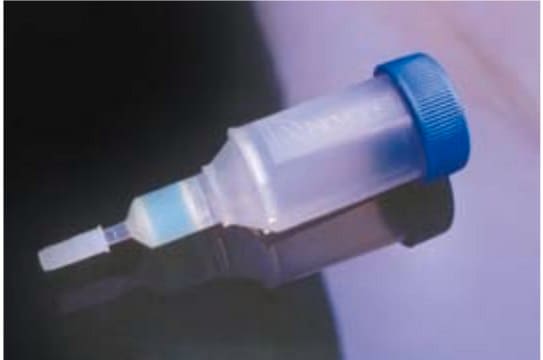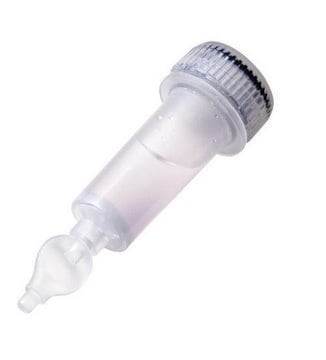For column chromatography, no more than 20 mM is suggested in the extract, equilibration, and wash buffers to prevent non-specific binding of proteins. No more than 250 mM is suggested for the elution buffers. Many proteins will elute with imidazole levels as low as 100 to 200 mM. For batch methods the imidazole concentration may have to be reduced or eliminated.When a protein is expressed at low levels, the presence of the imidazole limits the binding of the protein in the batch method but not when used in a column.
Wichtige Dokumente
P6611
HIS-Select® Nickel-Affinitätsgel
(1:1 suspension in a 20% ethanol solution)
Synonym(e):
Ni-NTA resin, nickel charged agarose
Größe auswählen
CHF 156.00
Voraussichtliches Versanddatum10. April 2025
Größe auswählen
About This Item
CHF 156.00
Voraussichtliches Versanddatum10. April 2025
Empfohlene Produkte
Konjugat
magnetic beads
Qualitätsniveau
Form
(1:1 suspension in a 20% ethanol solution)
Leistungsmerkmale
hydrophilic
Verpackung
pkg of 1 mL
pkg of 100 mL
pkg of 25 mL
pkg of 5 mL
pkg of 500 mL
Konzentration
1.5-2.4 mL/mL (suspension in packed gel)
Methode(n)
protein purification: suitable
Farbe
faint blue to very dark blue
Matrix
6% Beaded Agarose
Kapazität
>15 mg/mL, gel binding capacity (protein)(with an approx. 30 kDa protein)
Übergangstemp.
flash point 32 °C (closed cup)
Lagertemp.
2-8°C
Allgemeine Beschreibung
Anwendung
Leistungsmerkmale und Vorteile
- Hohe Selektivität für höhere Reinheit.
- Einzigartige nicht geladene hydrophile Bindung reduziert unspezifische Bindung.
- Die Bindungskapazität für histidinmarkiertes Protein ist größer als 15 mg/mL.
- Bindung unter denaturierenden oder nicht denaturierenden Bedingungen.
- Aufreinigung in einem Arbeitsschritt.
- Minimiert unerwünschte ionische Wechselwirkungen.
- Minimale Nickelauslaugung.
- Beadgröße: 45–165 μm.
Verlinkung
Physikalische Form
Lagerung und Haltbarkeit
Rechtliche Hinweise
Ähnliches Produkt
Signalwort
Warning
H-Sätze
Gefahreneinstufungen
Flam. Liq. 3
Lagerklassenschlüssel
3 - Flammable liquids
WGK
WGK 3
Flammpunkt (°F)
89.6 °F - closed cup
Flammpunkt (°C)
32 °C - closed cup
Hier finden Sie alle aktuellen Versionen:
Analysenzertifikate (COA)
Die passende Version wird nicht angezeigt?
Wenn Sie eine bestimmte Version benötigen, können Sie anhand der Lot- oder Chargennummer nach einem spezifischen Zertifikat suchen.
Besitzen Sie dieses Produkt bereits?
In der Dokumentenbibliothek finden Sie die Dokumentation zu den Produkten, die Sie kürzlich erworben haben.
Kunden haben sich ebenfalls angesehen
Verwandter Inhalt
Protein purification techniques, reagents, and protocols for purifying recombinant proteins using methods including, ion-exchange, size-exclusion, and protein affinity chromatography.
Proteinaufreinigungsverfahren, Reagenzien und Protokolle zur Aufreinigung rekombinanter Proteine unter Anwendung von Methoden wie Ionenaustausch, Größenausschluss und Proteinaffinitätschromatographie.
Proteinexpressionstechnologien für verschiedene Expressionssysteme zur Unterstützung von Forschung und der Herstellung von Arzneimitteln und Impfstoffen.
Protein expression technologies for various expression systems supporting research, therapeutics, and vaccine production.
-
Can imidazole be used with HIS-Select® Nickel Affinity Gel, Product P6611?
1 answer-
Helpful?
-
-
Why won't my recombinant protein with a histidine-containing tag bind to HIS-Select® Nickel Affinity Gel, Product P6611?
1 answer-
Verify the pH and composition of sample and equilibration buffers. Make sure there are no chelating or reducing agents present in the extraction buffer. If using the batch mode, remove imidazole. Run the affinity purification under denaturing conditions. Run a Western blot of the extract to verify that the recombinant protein is present.
Helpful?
-
-
Can I use SDS with HIS-Select® Nickel Affinity Gel, Product P6611?
1 answer-
0.1% SDS has been used with some samples, with no adverse effects on the observed protein binding. However, SDS will effectively coat proteins and may block the binding to the column. It is probably very protein-specific and an SDS concentration that works for one protein may not work for another.
Helpful?
-
-
What needs to be done if the HIS-Select® Nickel Affinity Gel, Product P6611, resin turns brown on reuse?
1 answer-
During purification many protein extracts tend to discolor an affinity gel during the loading step. The original color will return after the wash or elution step. If the color is still not changing strip and recharge the affinity gel with nickel. Wash with EDTA and recharge with Nickel solution.
Helpful?
-
-
What is the Department of Transportation shipping information for this product?
1 answer-
Transportation information can be found in Section 14 of the product's (M)SDS.To access the shipping information for this material, use the link on the product detail page for the product.
Helpful?
-
-
Can Tris buffers be used instead of phosphate buffer for HIS-Select® Nickel Affinity Gel, Product P6611?
1 answer-
Yes, Tris buffers should work.
Helpful?
-
Active Filters
Unser Team von Wissenschaftlern verfügt über Erfahrung in allen Forschungsbereichen einschließlich Life Science, Materialwissenschaften, chemischer Synthese, Chromatographie, Analytik und vielen mehr..
Setzen Sie sich mit dem technischen Dienst in Verbindung.









